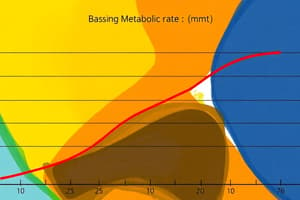Podcast
Questions and Answers
Which gene polymorphism has been associated with a tendency towards obesity?
Which gene polymorphism has been associated with a tendency towards obesity?
- MC4R polymorphisms
- LEP polymorphisms
- POMC polymorphisms (correct)
- FTO polymorphisms
How do epigenetic factors contribute to obesity onset?
How do epigenetic factors contribute to obesity onset?
- By influencing the structure of DNA
- By regulating gene expression without altering the gene sequence (correct)
- By eliminating the impact of environmental factors
- By causing direct mutations in gene sequences
What implication does maternal nutrition during gestation have on obesity risk?
What implication does maternal nutrition during gestation have on obesity risk?
- It has no impact on future obesity risk
- It can confer obesity risk to subsequent generations (correct)
- It can increase obesity risk in the mother only
- It only affects appetite regulation in the mother
What role does taste perception play in eating behavior?
What role does taste perception play in eating behavior?
What is suggested by studies regarding individuals whose gestational life involved maternal starvation?
What is suggested by studies regarding individuals whose gestational life involved maternal starvation?
What percentage of daily energy expenditure is attributed to basal metabolic pathways and autonomic nervous system activities?
What percentage of daily energy expenditure is attributed to basal metabolic pathways and autonomic nervous system activities?
Under sedentary lifestyle conditions, what is the maximum percentage that physical activity may account for daily energy needs?
Under sedentary lifestyle conditions, what is the maximum percentage that physical activity may account for daily energy needs?
What is the primary factor associated with the increased prevalence of obesity according to changes in daily living activities?
What is the primary factor associated with the increased prevalence of obesity according to changes in daily living activities?
What does NEAT stand for in the context of energy expenditure?
What does NEAT stand for in the context of energy expenditure?
How much of daily energy expenditure may NEAT account for?
How much of daily energy expenditure may NEAT account for?
Which statement best describes the relationship between obesity and physical activity?
Which statement best describes the relationship between obesity and physical activity?
What small, everyday activities are noted to contribute to energy expenditure and may impact obesity prevalence?
What small, everyday activities are noted to contribute to energy expenditure and may impact obesity prevalence?
What is the main conclusion drawn about sustained reduction of energy expenditure?
What is the main conclusion drawn about sustained reduction of energy expenditure?
What role do mitochondria play in the body?
What role do mitochondria play in the body?
How do brown adipocytes primarily differ from white adipocytes?
How do brown adipocytes primarily differ from white adipocytes?
What effect can moderate impairments in basal metabolic reactions have?
What effect can moderate impairments in basal metabolic reactions have?
What is an inevitable consequence of ATP production in mitochondria?
What is an inevitable consequence of ATP production in mitochondria?
What characteristic is associated with the membranes of mitochondria in brown adipocytes?
What characteristic is associated with the membranes of mitochondria in brown adipocytes?
Why is it challenging to identify universal associations between obesity and specific metabolic derangements?
Why is it challenging to identify universal associations between obesity and specific metabolic derangements?
What is the primary function of uncoupled mitochondria in brown adipose tissue?
What is the primary function of uncoupled mitochondria in brown adipose tissue?
What accounts for the majority of energy expenditure in the general population?
What accounts for the majority of energy expenditure in the general population?
What role does brown adipose tissue (BAT) activation play in obesity management?
What role does brown adipose tissue (BAT) activation play in obesity management?
What is a major activator of brown adipose tissue (BAT)?
What is a major activator of brown adipose tissue (BAT)?
Which factor has been identified as a negative modulator of BAT activity?
Which factor has been identified as a negative modulator of BAT activity?
How might exercise and nutrition influence BAT activation?
How might exercise and nutrition influence BAT activation?
Which of the following accurately describes the relationship between gut microbiota and host metabolism?
Which of the following accurately describes the relationship between gut microbiota and host metabolism?
What is emphasized about differentiation in adipocytes in terms of potential obesity treatments?
What is emphasized about differentiation in adipocytes in terms of potential obesity treatments?
What is a function of the gut microbiome according to the findings?
What is a function of the gut microbiome according to the findings?
Which statement reflects a misconception regarding exercise's effect on BAT?
Which statement reflects a misconception regarding exercise's effect on BAT?
Flashcards
Energy Expenditure
Energy Expenditure
The total amount of energy used by the body in a given period.
Physical Activity
Physical Activity
Activities that involve movement and use energy that are not basic living functions or exercise
Basal Metabolic Pathways
Basal Metabolic Pathways
Essential body functions like heartbeat, breathing, & organ function that require energy.
Non-Exercise Activity Thermogenesis (NEAT)
Non-Exercise Activity Thermogenesis (NEAT)
Signup and view all the flashcards
Obesity Epidemic
Obesity Epidemic
Signup and view all the flashcards
Daily Energy Needs
Daily Energy Needs
Signup and view all the flashcards
Fat Gain
Fat Gain
Signup and view all the flashcards
Reduced Physical Activity
Reduced Physical Activity
Signup and view all the flashcards
Brown Adipose Tissue (BAT)
Brown Adipose Tissue (BAT)
Signup and view all the flashcards
White to Brown Adipocyte Differentiation
White to Brown Adipocyte Differentiation
Signup and view all the flashcards
Cold Exposure and BAT
Cold Exposure and BAT
Signup and view all the flashcards
Catecholamines and BAT
Catecholamines and BAT
Signup and view all the flashcards
Inflammation and BAT
Inflammation and BAT
Signup and view all the flashcards
Exercise and BAT
Exercise and BAT
Signup and view all the flashcards
Gut Microbiota
Gut Microbiota
Signup and view all the flashcards
Gut-Brain Axis
Gut-Brain Axis
Signup and view all the flashcards
Basal Metabolic Rate (BMR)
Basal Metabolic Rate (BMR)
Signup and view all the flashcards
Metabolic Pathways
Metabolic Pathways
Signup and view all the flashcards
What happens when basal metabolic pathways are impaired?
What happens when basal metabolic pathways are impaired?
Signup and view all the flashcards
Mitochondria
Mitochondria
Signup and view all the flashcards
Uncoupling in Mitochondria
Uncoupling in Mitochondria
Signup and view all the flashcards
Uncoupling Proteins (UCP)
Uncoupling Proteins (UCP)
Signup and view all the flashcards
How do UCPs work?
How do UCPs work?
Signup and view all the flashcards
Candidate Genes for Obesity
Candidate Genes for Obesity
Signup and view all the flashcards
Taste Perception & Obesity
Taste Perception & Obesity
Signup and view all the flashcards
Epigenetics & Obesity
Epigenetics & Obesity
Signup and view all the flashcards
Gestational Environment & Obesity
Gestational Environment & Obesity
Signup and view all the flashcards
Transgenerational Obesity Risk
Transgenerational Obesity Risk
Signup and view all the flashcards
Study Notes
Energy Expenditure
- Maintenance of basal metabolic pathways and autonomic nervous system functions account for up to two-thirds of daily energy expenditure.
- Physical activity contributes up to 25% of daily energy needs, especially in sedentary lifestyles.
Basal Metabolic Rate (BMR)
- BMR (60-70%): Main metabolic rate.
- Thermic Effect of Feeding (5-10%): Energy used to digest and process food.
- Physical Activity (15-30%): Energy expended during movement.
- Other (2-5%): Includes miscellaneous energy use.
Energy Expenditure Levels
- No Exercise: 1.2
- Light Exercise (1 or 3x/week): 1.375
- Moderate Exercise (3 or 5x/week): 1.55
- Heavy Exercise (6 or 7x/week): 1.725
- Very Heavy (twice/day): 1.9
Factors Affecting Energy Expenditure
- Worldwide obesity is linked to lowered energy expenditure from less intense daily activities like walking, stair-climbing, and chores.
- Sustained small reductions in energy expenditure contribute to weight gain.
Non-Exercise Activity Thermogenesis (NEAT)
- NEAT covers postural changes and involuntary movements (e.g., fidgeting).
- NEAT potentially accounts for up to 5% of daily energy expenditure (data from studies).
- NEAT regulation occurs in the CNS (central nervous system) in some models.
- Obesity is associated with reduced physical activity impacting energy balance.
Metabolic Pathways
- Basal metabolic rate governs ATP/substrate oxidation, crucial for cell and organ function.
- Metabolic rate impairments impact energy balance leading to fat accumulation.
- Obesity's heterogeneity and variability make universal associations with metabolic derangements difficult to identify.
Mitochondria
- Mitochondria are the main site for substrate oxidation for ATP production across all tissues.
- ATP production is dependent on efficient oxidative reactions through the electrochemical gradients within the mitochondrial membrane.
- Incomplete energy production with partial dissipation of energy through uncoupling from ATP production is inevitable.
Brown Adipose Tissue (BAT) & Thermogenesis
- Brown adipose tissue differs from white tissue, primarily through heat production via fat oxidation.
- Brown adipocytes contain high concentrations of mitochondria enriched with uncoupling proteins (UCPs) to dissipate energy as heat.
Gut Microbiota
- Gut microbiota influences nutrient-host interactions and has crucial roles in the gut-brain axis.
- Its actions affect nutrient processing, neuroendocrine cells, and autonomic nervous system, influencing energy metabolism.
Genetic and Epigenetic Factors
- Genes governing eating behaviors and appetite homeostasis frequently influence obesity risk.
- Taste perception and food preferences have a genetic component related to appetite control.
- Epigenetic factors like those involving maternal diet during gestation also play a role in the individual's predisposition towards weight gain.
Studying That Suits You
Use AI to generate personalized quizzes and flashcards to suit your learning preferences.




